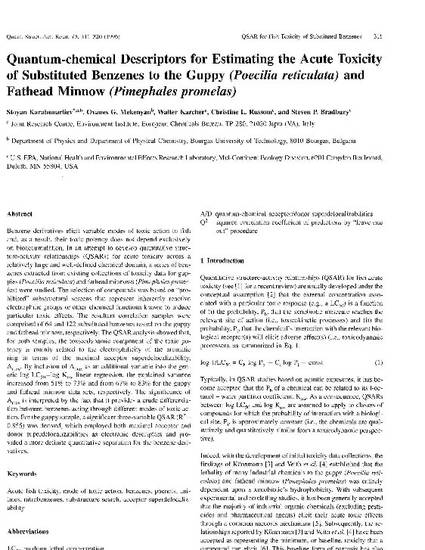
Article
Quantum-chemical Descriptors for Estimating the Acute Toxicity of Substituted Benzenes to the Guppy (Poecilia reticulata) and Fathead Minnow (Pimephales promelas)
Quantitative Structure-Activity Relationships
(1996)
Abstract
Benzene derivatives elicit variable modes of toxic action to fish and, as a result, their toxic potency does not depend exclusively on bioaccumulation. In an attempt to develop quantitative structure-activity relationships (QSARs) for acute toxicity across a relatively large and well-defined chemical domain, a series of benzenes extracted from existing collections of toxicity data for guppies (Poecilia reticulata) and fathead minnows (Pimephales promelas) were studied. The selection of compounds was based on “prohibited” substructural screens that represent inherently reactive electrophilic groups or other chemical functions known to induce particular toxic effects. The resultant correlation samples were comprised of 64 and 122 substituted benzenes tested on the guppy and fathead minnow, respectively. The QSAR analysis showed that, for both samples, the toxicodynamic component of the toxic potency is mainly related to the electrophilicity of the aromatic ring in terms of the maximal acceptor superdelocalizability, Amax. By inclusion of Amax as an additional variable into the generic log LC50 - log Kow linear regression, the explained variance increased from 51% to 73% and from 67% to 83% for the guppy and fathead minnow data sets, respectively. The significance of Amax is interpreted by the fact that it provides a crude differentiation between benzenes acting through different modes of toxic action. For the guppy sample, a significant three-variable QSAR (R2 = 0.855) was derived, which employed both maximal acceptor and donor superdelocalizabilities as electronic descriptors and provided a more definite quantitative separation for the benzene derivatives.
Keywords
- Acute fish toxicity,
- mode of toxic action,
- benzenes,
- phenols,
- anilines,
- nitrobenzenes,
- substructure search,
- acceptor superdelocalizability
Disciplines
Publication Date
August, 1996
Publisher Statement
Works produced by employees of the U.S. Government as part of their official duties are not copyrighted within the U.S. The content of this document is not copyrighted.
Citation Information
Stoyan Karabunarliev, Ovanes G. Mekenyan, Walter Karcher, Christine L. Russom, et al.. "Quantum-chemical Descriptors for Estimating the Acute Toxicity of Substituted Benzenes to the Guppy (Poecilia reticulata) and Fathead Minnow (Pimephales promelas)" Quantitative Structure-Activity Relationships Vol. 15 Iss. 4 (1996) p. 311 - 320 Available at: http://works.bepress.com/steven_bradbury/62/
